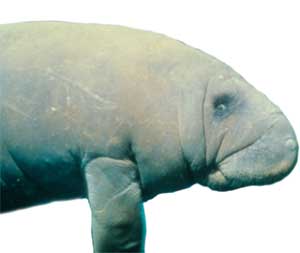|
|
Manatee Eyes Could Be Window To Their Healthdownloadable pdf
For Florida manatees, the eyes may have it, say University of Florida researchers studying whether the mammals’ unusually thick tear film helps protect against disease and could be used to gauge the endangered sea cows’ ability to fight stress from cold water temperatures. Manatees depend on both natural and artificial warm-water refuges like those found near coal-burning power plants to survive cold winters. As older coal-burning power plants are phased out in the next 10 to 20 years, researchers fear chronic exposure to cooler waters could weaken the large herbivores’ immune system, and they could sicken or even die. By sampling manatees’ tear film in addition to performing other standard tests, scientists think they might be able to more efficiently evaluate manatees’ immune system function and better determine strategies for rescue, treatment and rehabilitation. The current tear analysis project, believed to be the first of its kind, builds on work UF veterinary scientists published recently in the journal Veterinary Ophthalmology that described the abundance of blood vessels found in manatee corneas. Blood vessels could have a tendency to move into the cornea to supply oxygen because the tear film creates a barrier so thick that oxygen present in air can’t penetrate it, said Don Samuelson, a professor of ophthalmology in the Marine Mammal Medicine program at UF’s College of Veterinary Medicine. Manatees are believed to have the thickest tear film of any sea mammal, and possibly of any animal, Samuelson said. In general, mammals produce tears to protect against infection because the eye itself does not have immune system components. “Through this protection against the potential for infection, the manatee is able to enter murky waters just rich with potential pathogens,” Samuelson said. “For that reason, we think this very thick tear film, undoubtedly rich with antimicrobial components, serves to protect in areas that could otherwise be devastating.” Researchers speculate that tears, which can be collected without removing manatees from the water using a small, soft cotton swab, may one day be used along with or instead of blood tests to assess health status and to gauge whether the mammals were recently exposed to health threats such as red tide. Ongoing UF studies are exploring the relationship between the tear film and blood vessel formation. “One of the findings of our earlier work was that there is absolutely no pathology involved in the formation of these manatee blood vessels, which in other species occur predominantly because of trauma or disease,” Samuelson said. “So the question is, why do these mammals have such thick tears that corneal blood vessels form naturally, even in the fetus?” Samuelson collaborated with Roger Reep, a UF professor of neurology, and Jenny Harper, a recent doctoral graduate who is now an assistant professor at Coastal Georgia Community College. Together they examined 26 eyes from 22 individual manatees and constructed 3-D images of the corneas. “We’ve completed the evaluation and mapped the blood vessels, so we know where within the cornea they are located and how many there are,” Samuelson said. “Our next goal is to start examining the tears and evaluate them with regard to the whole animal’s health status.” Tear analysis is being used in human ophthalmology and is in its early stages in veterinary medicine, he said. Kendal Harr, assistant director of UF’s Marine Mammal Medicine program, is collaborating with Samuelson on a large federal Fish and Wildlife Service research initiative to assess the immune function of manatees at Homosassa Springs State Park. She is coordinating sample and data collection for the UF veterinary college as part of the project. Don Samuelson, samuelsond@mail.vetmed.ufl.edu |

